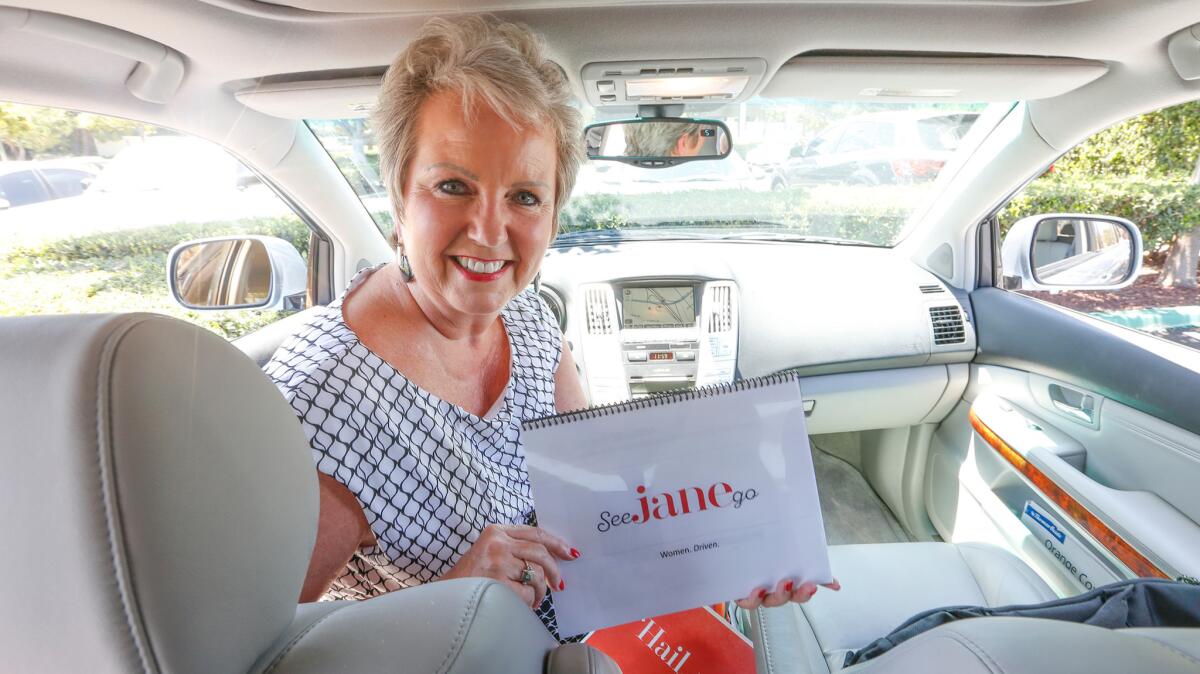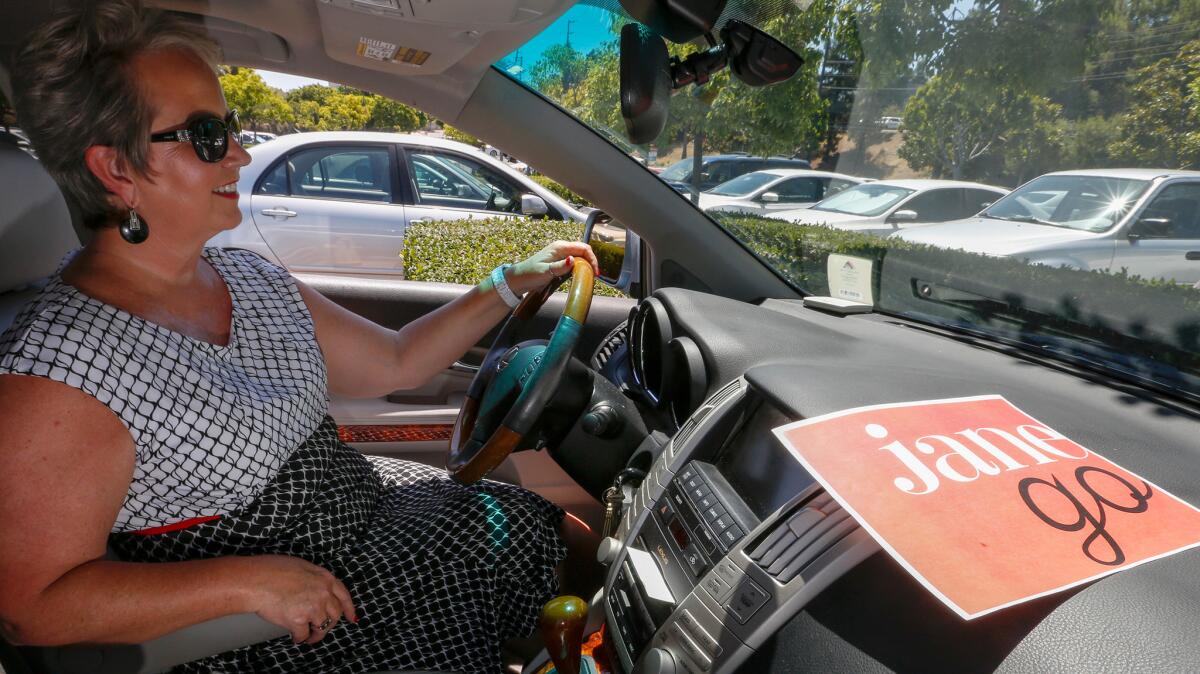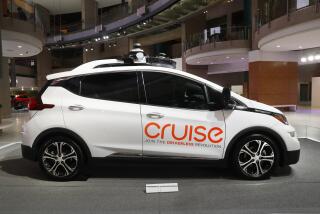Uber ... for women? Start-ups hope to match female passengers with female drivers

- Share via
Reporting from San Francisco — Ginny Young sat with eight women, all of them senior citizens, this spring while a focus group leader lobbed questions at them.
“Who has used Uber or Lyft before?” Young raised her hand.
“How about taxis?” A few more hands went up.
“If you booked a ride, would you prefer if the driver was a woman?” Absolutely.
“And how many of you would use a ride-hailing service where all the drivers are women?” Every hand in the room shot up.
“There was a whole group of us saying we’d feel more comfortable and more at ease with a woman driver,” said Young, 86, of Laguna Niguel. “I think it’s a great idea.”
That’s the sentiment Orange County start-up See Jane Go is banking on for its launch this fall.
The ride-hailing company, headed Kimberly Toonen, a former Apple and Cox Communications employee, plans to offer an alternative to Uber, Lyft and taxis by catering specifically to women who don’t feel comfortable getting into a car with a male stranger. In Boston, a similar ride-hailing start-up, Safeher, also plans to launch later this year with a fleet of women drivers.
The companies are among a number of start-ups popping up to serve customers that they believe the Ubers and Lyfts of the world are leaving behind: senior citizens, children and, increasingly, women. In L.A., HopSkipDrive has spent the past year signing up drivers with childcare experience to give rides to minors (Uber and Lyft don’t allow minors to ride alone). In the Bay Area, Zum offers on-demand transportation for kids, and throws in babysitting services too.
“As wonderful as ride-hailing is, we thought there may be an option for women,” said Toonen, who became See Jane Go’s chief executive in March shortly after Orange County financial advisor William Jordan proposed the idea of a women-only ride-hailing company. “William is a family man and a doting, protective father, and he wasn’t comfortable with the idea of his daughter riding in or driving with Uber or Lyft. So we asked ourselves, is there a business here?”
In the tech world, there is no shortage of companies trying to take on incumbents. Most struggle to fund-raise and grow. Others fizzle before they even launch. Some place priority on ideological positions, with their existence serving to protest the status quo – like Ello, an ad-free alternative to Facebook, or Juno, a ride-hailing firm that offers drivers equity in the company.

Most tech experts agree that going head-to-head with Facebook or Uber will not bode well for newcomers, but upstarts like See Jane Go say zigging when industry giants zag will allow them to carve out a sustainable niche.
Considering only 15% of Americans have used a ride-hailing service, there are still large pieces of the pie up for grabs.
“It’s a good idea because specialization can often open up opportunities,” said Karl Brauer, an analyst with Kelley Blue Book. “If you pick a geographic area, specialize in a demographic and serve it well, it might be possible.”
But these start-ups will likely face tremendous head winds. While focus groups suggest that a ride-hailing service for women is a good idea, “the idea alone is never enough,” said Jennifer Polk, an analyst with research firm Gartner.
“Will there be enough demand?” Polk said. “This is a niche, and I don’t mean niche as in ‘women,’ but ‘women who use ride-hailing services in these cities who are concerned enough about their safety that they would consider a female-only ride-hailing program.’ ”
Polk notes that, empirically, Uber, Lyft, and taxis aren’t unsafe. Millions of passengers — male and female — take rides daily without incident. For many women, a driver’s gender is a non-issue, and neither Uber nor Lyft have announced plans to develop gender-specific features for their apps. So will there be enough customer demand to support the start-ups?
And if there is, business experts question whether there will be enough supply.
“These companies are really disadvantaged because they have much less dense networks of cars,” said Evan Rawley, a professor at the Columbia School of Business.
The ride-hailing business is a two-sided marketplace in which companies have to ensure there are enough drivers on the road to serve all the passengers who need rides, Rawley said. Uber and Lyft have spent years and millions of dollars balancing supply and demand, and they’ve achieved that critical mass because they’ve opened their services to everyone – not just half the population.
Smaller start-ups that have tried to achieve a similar critical mass have fallen by the wayside: Sidecar sold its assets to General Motors this year after it struggled to compete with Uber. SheRides, a New York taxi firm launched by women for women in 2014, has all but disappeared — its product is no longer available on the Apple App store, and phone calls and emails to the company went unanswered.
“In the modern age of tech, for every business that succeeds, about 100 fail,” Brauer said. “So if you’ve got Uber and Lyft, that means 200 other companies have already, or will, fail.”
Another potential hurdle the companies face is claims of gender discrimination from men who might want to drive for the service (both See Jane Go and Safeher have features in place for men who want to ride with the service – the former will connect the customer with a third party ride-hailing company, the latter said it will transport men, but the app for male users will have different features than the women’s version. The company did not detail what these features will be).
See the most-read stories in Business this hour »
But Elizabeth Brown, an assistant professor of business law at Bentley University, believes there’s a case to be made that gender-specific ride-hailing should be exempt from civil rights and public accommodation claims, in the same ways that single-sex gyms get a pass. Overseas, single-sex public transportation has existed for years, with women-only buses in India and train cars in Japan.
“The safety situation for riders and drivers is different from truly public spaces,” Brown said. “I think what [these companies are] doing intuitively makes sense, and there are many situations where the law just has to catch up to society, or tech, or both.”
See Jane Go has so far raised $1 million from private investors and is seeking an additional $5 million. Safeher declined to reveal how much it has fund-raised. Neither have announced a pricing structure yet, but both said fares would be competitive with other ride-hailing services.
See Jane Go plans to launch in Orange County in the fall, before expanding to Los Angeles. Toonen estimates the company will need around 400 drivers at launch — a fraction of the 160,000 drivers Uber has in California.
When the app launches, customers will be able to decide at the time of booking what kind of ride experience they’d like – whether they are feeling chatty or would prefer to ride in silence. The company will take a 20% cut of drivers’ fares, of which 1% will go to a charity that benefits women of the driver’s choice, and another 1% of the rider’s choice.
In the end, the cost of a ride might end up being more expensive than taking Uber. The wait times could end up being longer. But for potential customers like Young, it’ll be worth it for peace of mind.
“I’m all for it,” Young said. “I would take them over a taxi any day.”
Twitter: @traceylien
MORE BUSINESS NEWS
New Age shops offering crystals are experiencing a resurgence in L.A.
Donald Trump provides unconventional story for TV coverage of convention
Wells Fargo earnings slip, but they mostly meet expectations







